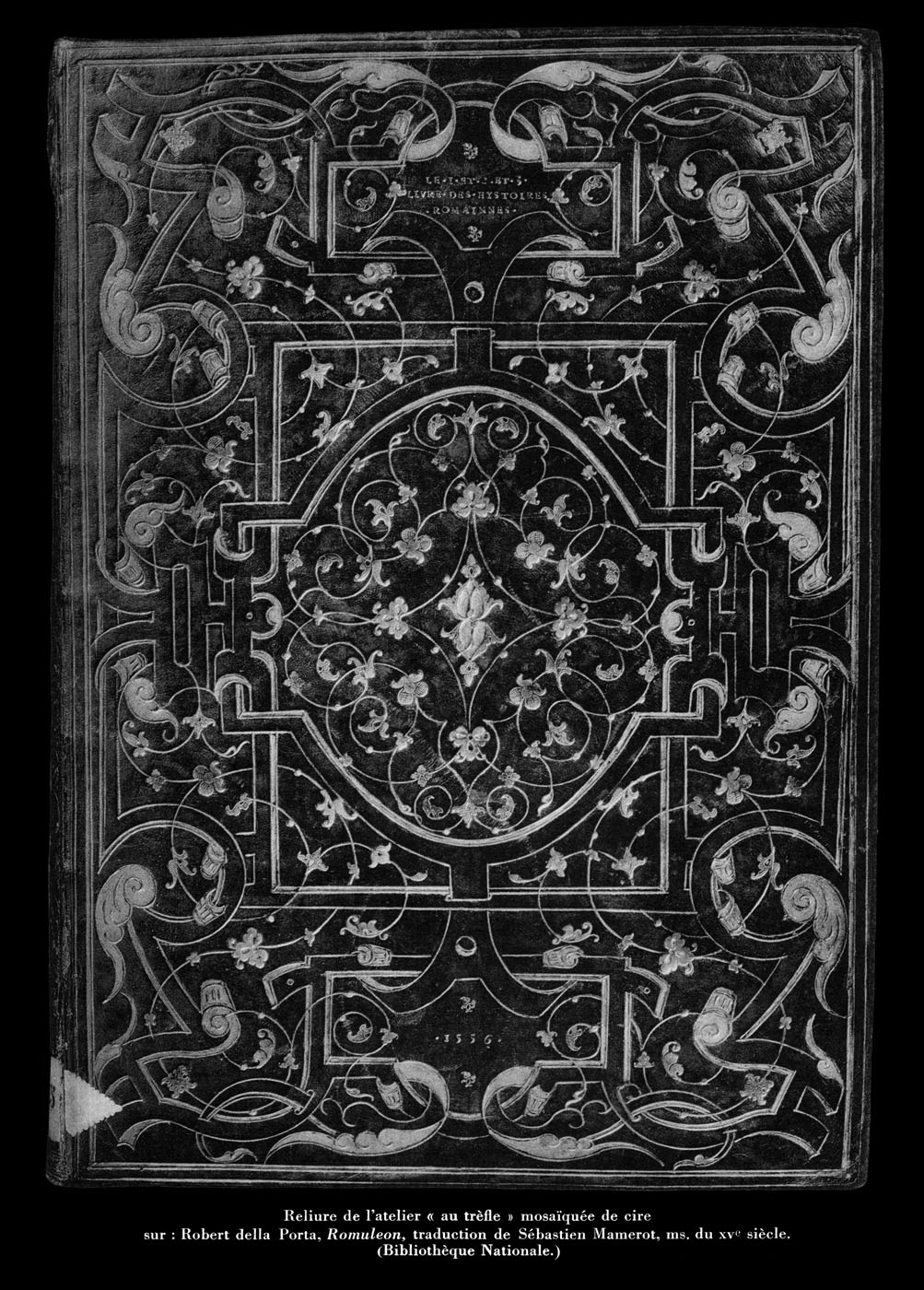

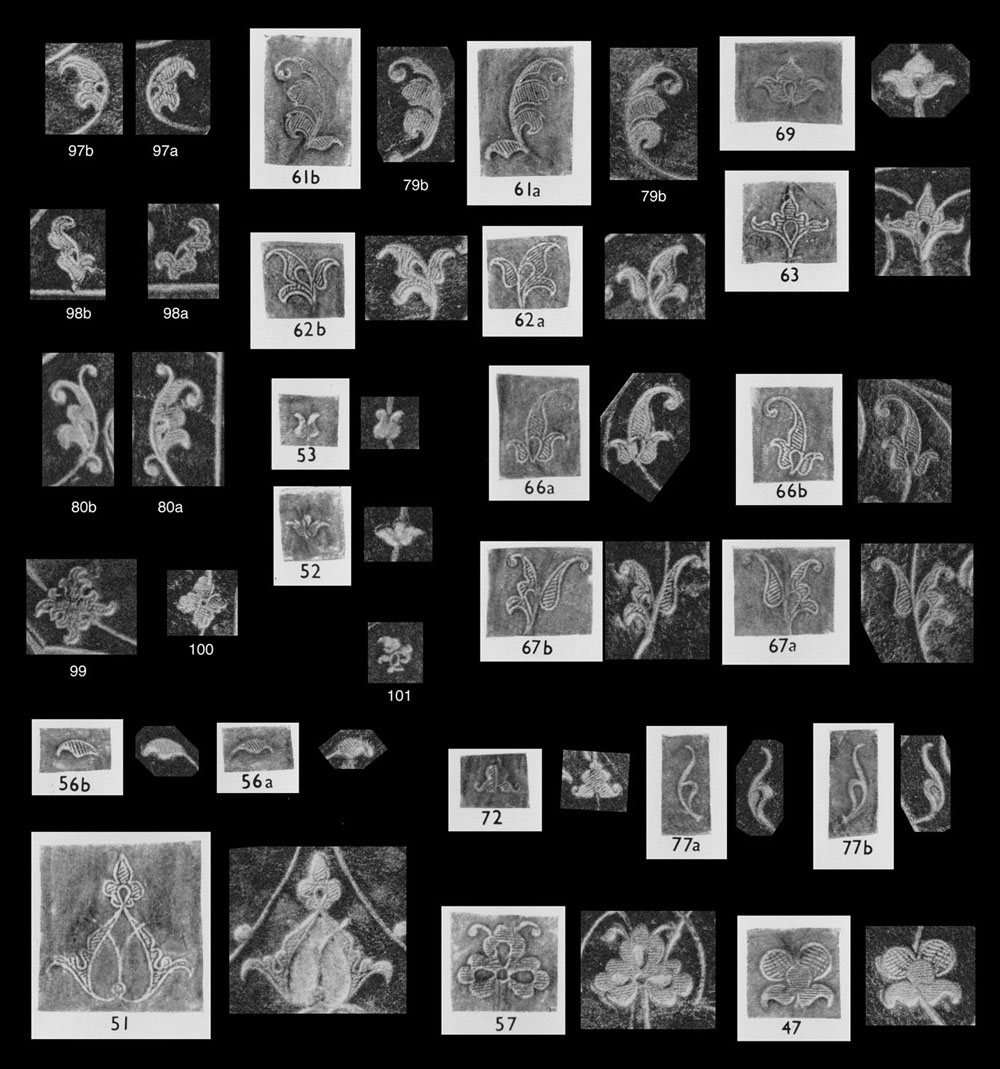
| On a previous page we were looking at an important bit of text from H. D. Hobson's extensive research on Fanfare bindings Les reliures à la fanfare, I may as well copy it again here. |
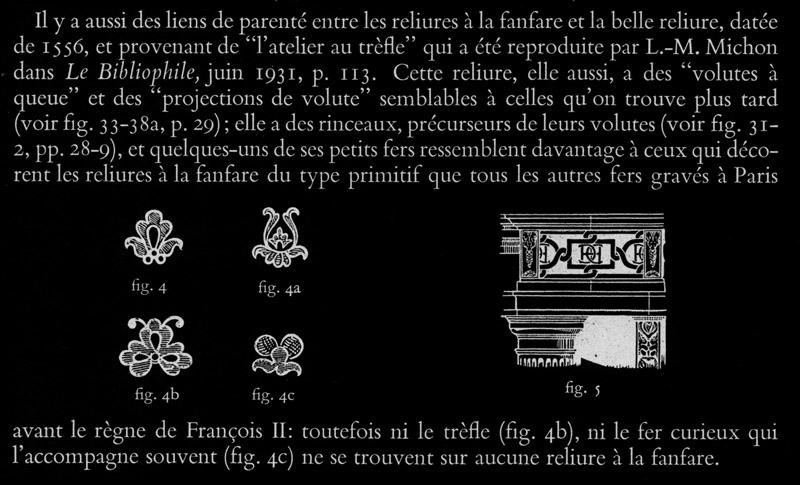
|
In this text, Hobson notes a strong relationship between the early fanfare bindings and a binding reproduced in a 1931 article by L. M. Michon in Le Bibliophile. I find these kind of references very exasperating, because to understand what he is saying you have to actually see this binding, that is relatively hard to find (no one has it online). It is found in a rare publication of which they only printed 1000 softcover copies, most of these, will have been scooped up by the worlds major libraries. Anyway I was determined to see this binding and I finally found on eBay an immaculate set of the 5 Bibliophile editions produced in 1931. Now some weeks later it has arrived, and we can see at last this important binding (shown at the top of this page). L. M. Michon's article is today still very interesting, even though now, we know a lot more about the so called atelier au trefle, for a start we know that the tools that decorated this binding (shown above) became part and parcel of the royal atelier at Fontainebleau. Perhaps first used by Picard up till around 1548 and then by Gomar Estienne and Claude Picques for many years to follow, so in fact the atelier au trefle is the atelier royal (atelier du reliure du roi). For some reason Hobson did not think that the early fanfare bindings derived from this atelier even though he recognized in this binding the unmistakeable signs of things to come in the fanfare bindings, namely scrolls and scrolls with wings. but this issue is not the subject of this page. In this article entitled: A Propos Des Reliures De L'atelier "au trèfle," Michon points out a very interesting if not mysterious connection to the azured tools that suddenly appeared and quickly dominated French decorative bookbinding in the middle of the 16th century. In the last few months we have examined the rapid spread and proliferation of another group of tools (solid tools) and decorative designs found on bindings in the period of 1538 to 1545. All this suddenly changed with the invention of azured tools such as those shown in Comparative Diagram 1. Where did these tools come from? Perhaps the engraving shown below, and reproduced in Michon's article, holds the key to this mystery. |
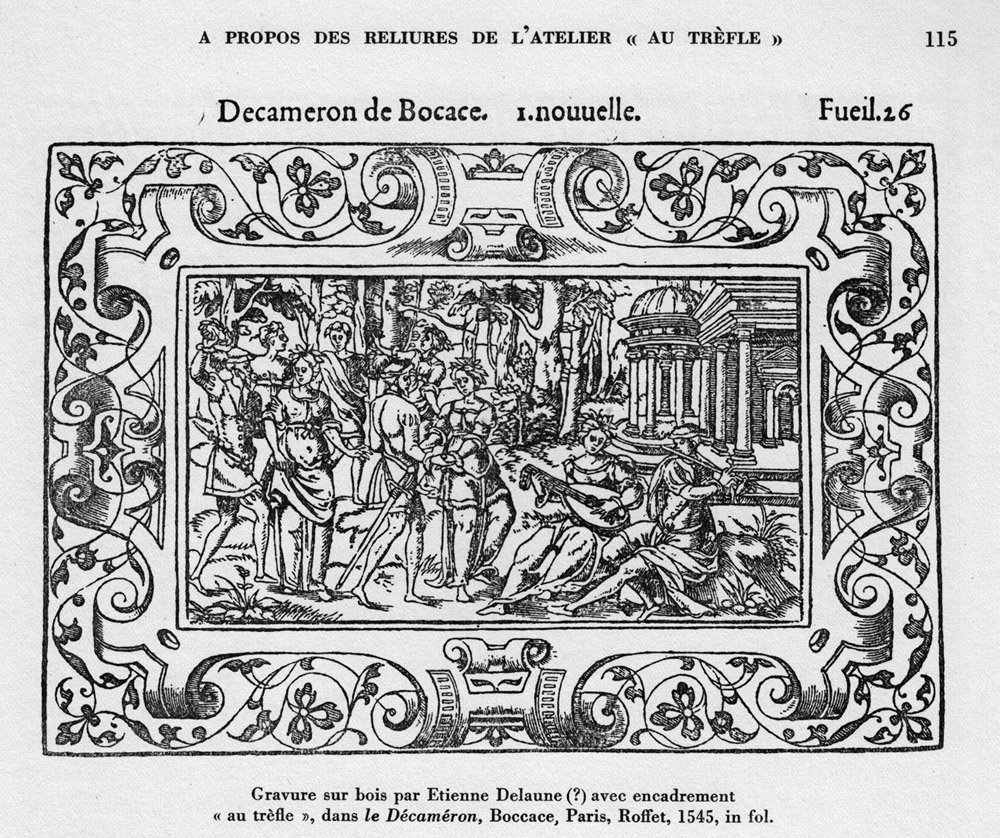
|
The engraving comes from a 1545 French translation of le Decameron, by Boccace, printed in Paris, by Estienne Roffet who was at this time also the Kings official binder and privalaged printer. Here we discover, in the decorative frame that was used repeatedly to enclose all the illustrations in this book, details that could have inspired the azured tools and other scrolling elaborations that we see in the decoration of the 1556 binding at the top of this page. If conversely, these designs were somehow a copy of the azured tools then then we might expect, the so called trefle to have horns (see imprint 57 in Comparative Diagram 1 and fig. 4b in Hobson's text). Really the printing date of 1545 would seem to rule out that possibity, as the azured tools appear somewhat later. This engraving has often been attributed to Etienne Delaune, Michon questions whether Delaune could have been the artist who made this engraving. I have just now searched for and found a few examples of Delaune's engravings in which one of sees a strong dose of the grotesque. These signed Delaune prints are dated to approximately c. 1560-1570 (see these prints), Michon states that Delaune only started engraving around 1560, and thus does not think these engravings from 1545 or earlier can be attributed to him. I decided to research this further and found that Delaune was first and formost, a metal worker, Below is photograph of a shield Delaune designed for Henri II, there is an enlargement of it on the Wikipedia page where I found this image and is well worth a look as it is a true masterpiece, where-in we can detect the influence and style of Benvenuto Cellini with whom Delaune worked/apprenticed 1540-1545, the very period that the Decameron engravings derive from... |
| Etienne Delaune (Orléan 1518/19-1583) was trained as an engraver of medals, and worked with Benvenuto Cellini during the latter's stay in Paris from 1540-1545. By 1552, Delaune was employed as chief medallist at the royal mint, founded by Henry II, and in 1556 he furnished designs for Henry's parade armour. His extant prints consist mostly of allegorical subjects within rich, ornamental surrounds and are exeptional for their technical precision despite their often small size. Delaune's rare surviving drawings reveal the influence of Primaticcio and the school of Fontainebleau and his engravings helped to spread the Fountainebleau style among artists and craftsmen in France and beyond. |
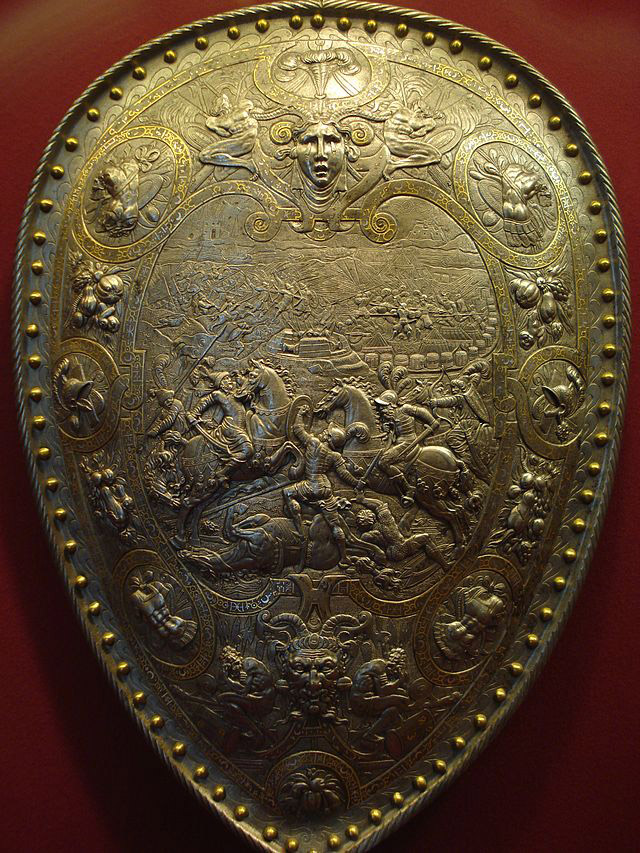
| Shield of Henry II of France. Steel, embossed and damascened with silver and gold. The embossed scene at the center of the shield is an illustration of Hannibal's victory of the Romans at Cannae in 216 BC, a metaphor for France against the armies of the Holy Roman Empire in the 1500s. The design of the shield is attributed to Paris goldsmith Etienne Delaune. |
|
We need to delve further into this mystery. In a 2013 Christies auction catalogue listing we still find this attribution to Delaune:
|
|
BOCCACCIO, Giovanni (ca 1313-1375). Le Decameron. Translated by Antoine Le Maçon. Paris: [L. Blaublom?] for Étienne Roffet, 1545. 2o (322 x 210 mm). 10 metalcuts, one at the head of each text division, attributed to Étienne Delaune; criblé initials in four sizes. FIRST EDITION of Antoine Le Maçon's translation which was commissioned by Marguérite d'Angoulême, queen of Navarre, whose own Heptaméron was is based on this work. "Le Maon's dedication to Marguérite is printed in roman letter on leaf ã2 and reprinted in italic on leaf a1. In most copies, one of these duplicate leaves has been removed. Fairfax-Murray French 46; Mortimer French 106. |
| From another auction catalogue: |
|
This edition, the most beautiful published in the 16th century, is illustrated with 10 engravings, "counting among the engraving master-pieces of Renaissance".
Robert Brun (Le Livre illustré français de la Renaissance) describes the illustration attributed to Etienne Delaune like that: "A suite of 10 charming vignettes (60 x 105) placed in frames with the style of cut leather, of which some elements seem to have been used as models for the decorative tools of "l'atelier au trefle". The vignettes have been relief engraved on metal, as the existence of the original block of the first day that used to possess Eugène Piot which has been reproduced in the 'Cabinet de l'amateur' proves it.
These vignettes, freely imitated from those in the Giolito edition in Venice in 1542, are amongst the master-pieces of engraving at this time and are usually attributed to Etienne Delaune, though the redactor of the Harvard catalog notices that the most ancient work dated of this artist wasn't before 1565". Robert Brun (Le Livre illustré français de la Renaissance) décrit ainsi l'illustration attribuée à Etienne Delaune : « Suite de 10 charmantes vignettes (60 x 105) placées dans des cadres genre cuir découpé dont certains éléments semblent avoir servi de modèle au relieur de l'atelier dit 'au trèfle'. Les vignettes ont été gravées sur métal en relief, ainsi que le prouve l'existence du bloc original de la première journée que possédait autrefois Eugène Piot qui a été reproduit dans le 'Cabinet de l'amateur'. Ces vignettes librement imitées de celles de l'édition de Giolito à Venise en 1542 comptent parmi les chefs-d'¦uvre de la gravure à cette époque et sont habituellement attribuées à Etienne Delaune, cependant le rédacteur du catalogue Harvard fait observer que le plus ancien ouvrage daté de cet artiste n'est que de 1565. |

|
From these leads, where it is claimed that the French 1545 engravings were copies of the Italian edition of 1542, These vignettes, freely imitated from those in the Giolito edition in Venice in 1542. I decided to follow this up looking for images of the 1542 edition and found a comparative diagram (shown above) that shows even a 1492 edition, as well as the 1542 and 1545 each being a sort of copy of the previous edition. However this only proves that the 1545 border design elements did not come from the Italian editions. Finally after a long search I have found evidence to indicate that Etienne Delaune did probably have something to do with the 1545 Decameron engravings, we will tackle that on the next page... |
| information about the author | return to the home page of VIRTUAL BOOKBINDING |